From the daily news to your LinkedIn feed, you have probably noticed layoffs across the tech industry over the past 2 years.
These include UX writing and content design layoffs, as well as pretty much every other role. After a boom during the pandemic lockdowns, tech companies have reduced staff sizes considerably.
Whether you have a content design job or are looking for a new one, this news can feel frightening and demoralizing.
But there is no reason to be deterred from UX writing and content design as a field. While it’s important to be aware of the reality of UX writing and content design layoffs, there are many things you can do to improve your success on the job and on the job market – and to take care of yourself in the process.
This post will take stock of the state of UX writing and content design layoffs. Then, we’ll offer some tips for employed content designers who want to future-proof themselves, and some coping strategies for laid off content designers to make the job search as smooth as possible.
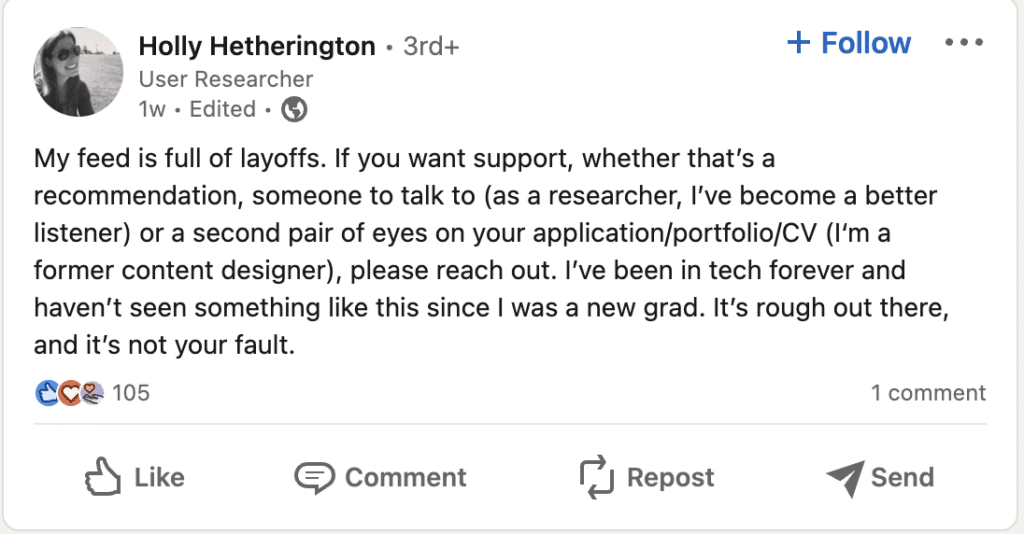
UX Writing and Content Design Layoffs: What you need to know
UX Writing and Content Design Layoffs Can Happen to Anyone
The past few years have seen layoffs at nearly every major tech company, from Facebook and Google to Discord and Twitch. And seniority doesn’t appear to offer much protection.
In a small survey (n=239) of UX designers, Matej Latin found a startling trend: a significant chunk of those laid off are senior or higher, making up 60% of affected employees.
Only 24% were intermediate, and 10% were juniors. Here is the chart from Latin’s post:
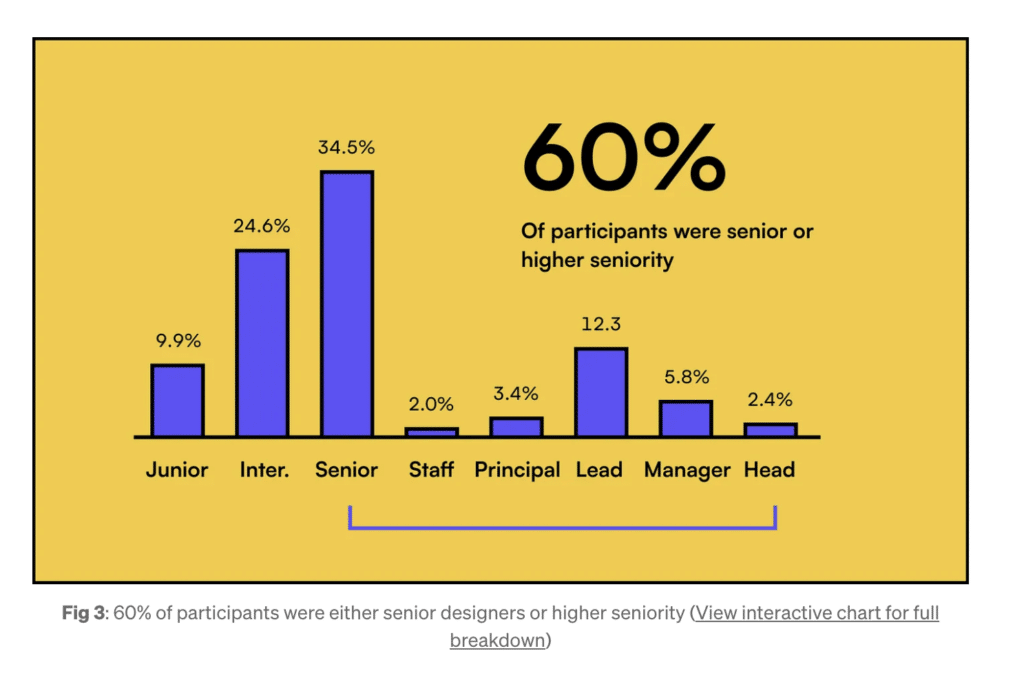
While this sample size is small, it highlights the fact that layoffs can happen to anyone. And note that this survey was of UX designers, so we don’t know whether similar statistics apply to UX writing and content design layoffs as well.
Another post from Matej Latin provides several personal layoff stories, including this one, from an experienced and successful designer.
Eva, a high-performing designer from Denmark was let go when her company’s stock plummeted. Her firing highlights a disconcerting disconnect between performance and job security.
And Eva’s story is not an outlier; it’s a reflection of a larger issue at play in the tech world. In fact, Latin’s research suggests that 52% of the laid off designers in his sample were high performers, as shown in his chart below.
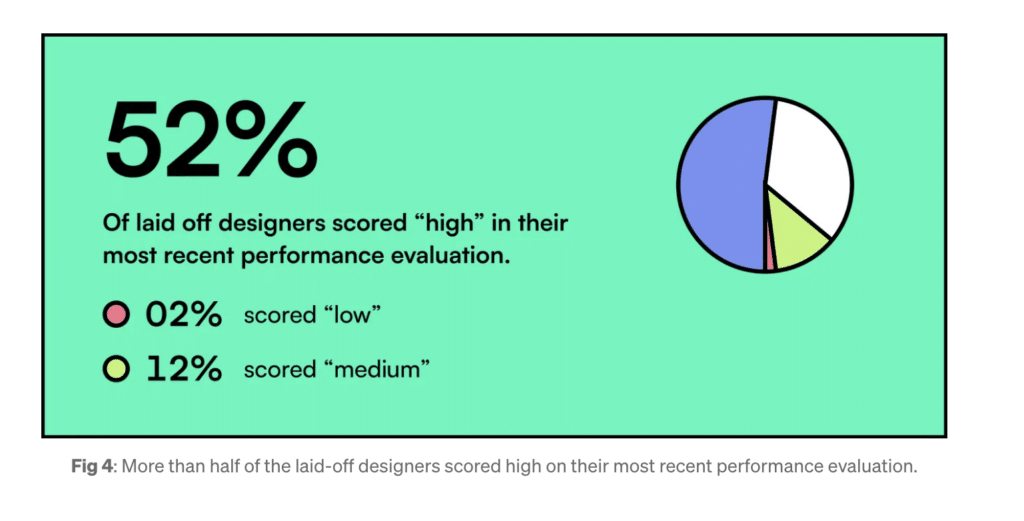
The Domino Effect of UX Writing and Content Design Layoffs 🎲
The impact of layoffs extends beyond numbers; it reshapes the very fabric of teams.
With fewer employees, those who remain are asked to do more, and may have diminished morale after losing co-workers. The ripple effects? Burnout, diminished work-life balance (WLB), and a sense of working for an entirely different company.
AI and the Future of UX Writing and Content Design
As companies like Meta, Google, and Amazon trim their UX teams, a new player enters the arena—AI.
With AI tools increasingly taking over more and more tasks, the role of human UX professionals is in jeopardy. This shift towards leaner teams equipped with AI might be economically rational, but it also brings forth questions about creativity, empathy, and the nuanced understanding that human designers bring to the table.
Since companies are increasingly using AI, it’s worthwhile to learn more about using it to help you work. AI still does not sound human, and it can’t bring the knowledge, skill, and personality to UX writing that a human can. Learning to use AI for what it is good at can help you to focus on what you are good at, and that can make work easier and more efficient.
Reasons for hope
No doubt, times are tough. But there are reasons to be optimistic about the future for UX writers and content designers.
This post lays out some compelling evidence that even in the face of UX writing and content design layoffs, we should not count the field out yet. Mainly, that’s because our work is important to the success of digital products.
Poor content design makes products difficult to use and drives users away. So despite the many challenges in the current job market, if you are passionate about UX writing, stay in the game. Your skills are needed.
Weathering the Storm: Strategies for Survival 🍃
In these turbulent times, how does one navigate the uncertainty of UX writing and content design layoffs? Whether you are employed and hoping to stay that way, or are struggling to know what to do after a layoff, there are things you can do to ease the journey.
Future-proofing Yourself: Tips for employed content designers
While there is nothing that can definitively protect you from layoffs, and it is important to remember that layoffs don’t reflect anything about the skill, dedication, and talent of a content designer, there are some strategies that you can use to be on the right side of a downsizing.
Be a great co-worker.
Engage with your team, share knowledge, and take the lead in meetings. Being a source of calm and direction can set you apart. In addition to offering some protection against a layoff, being a good team member can also help if you are laid off. If co-workers and managers have positive feelings towards you, they are more likely to help you in the future. (Plus, it’s nice to be nice.)
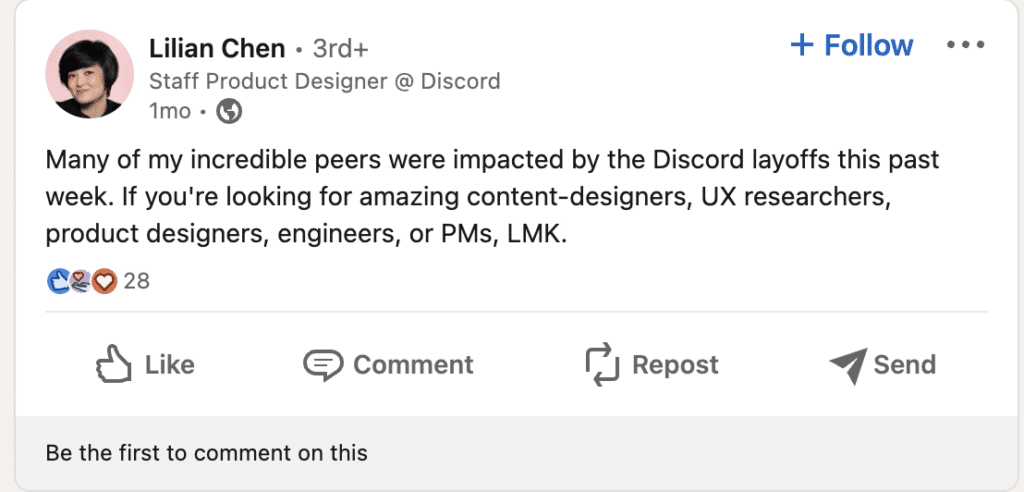
Demonstrate your value.
This really boils down to doing great work. Take every opportunity to showcase your skills. Be on the lookout for places you can contribute – if you can show up to help in a difficult situation, people will likely take notice. Being the problem-solver can make you indispensable.
Keep growing.
When you’ve been in a job for a while, it can be easy to get into a rut. While this is completely natural, it’s wise to take the chance to expand your skill set whenever possible. If your company has an education stipend, use it. Or, take a few hours a week to learn more about an area of your field that interests you or aligns with where you want to go in your career.
All the better if you share what you’re learning on a blog or social media posts. Continually learning will help you stand out in your current job, and make it easier to change jobs later if you need or want to.
Moving Forward: Tips for laid off UX writers and content designers
If you have been laid off, there are many things you can do to take care of yourself and gear up for a successful job search.
Take a breath.
If you’ve just been laid off, you are probably experiencing many difficult emotions. Anxiety, fear, betrayal, anger, shame, and more. You’ve just experienced a major life event, and it’s normal to feel unmoored. Self-care is important at a time like this, so take some time to process what has happened.
If you’ve been working at a high-stress job, it might be helpful to slow down and do some of the things you wished you could do while you were working around the clock – sit on a park bench, go to the beach, watch a movie during the day.
Slow and steady wins the race.
After a bit of relaxation and processing time, however, it is essential to start the job search before you lose momentum. But pace yourself: however tempting it may be, going at a breakneck pace is likely to lead to burnout. While you may be lucky enough to get a new job quickly, a job search can be like a marathon.
Consistency is key – take a few manageable actions each day. (And leave time for restorative activities as well.)
Share your story.
Although everyone knows that UX writing and content design layoffs are common these days, people who have been laid off still may feel a lot of shame about it. A simple LinkedIn post sharing your layoff story can help reduce these feelings, as your network is likely to respond with encouraging and sympathetic posts.
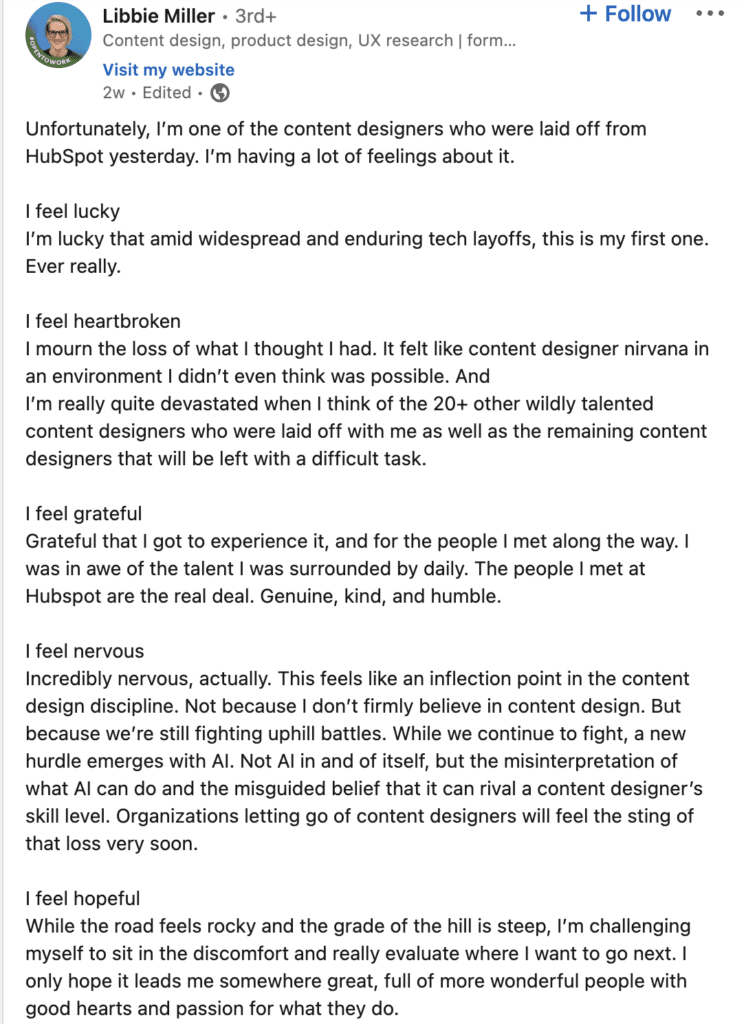
In this post, Andrew Astleford lays out how sharing his story helped him navigate his layoff and helped his job search. He emphasizes framing your layoff narrative as a comeback story, a tale of growth and resilience.
You can keep posting throughout your job hunt, even making a LinkedIn post part of a daily ritual. Practices like this help with accountability, and can raise awareness. You want to be someone people think of when they hear about a job in your field. If you’re upskilling or working on a passion project, this is a great place to highlight those efforts.
Keep in touch.
Sharing your story is one form of networking. It’s also important to keep in touch with communities in your field (and out of it, in case your uncle or college buddy has a friend at your dream company). Stay active in social media groups in your industry, posting useful info (and/or great memes), and offering support to others.
If you were let go as a part of mass layoffs, make sure to stay in touch with others who were let go. These folks at HubSpot in the post strategized their way through the layoff journey together, supporting each other in the process.
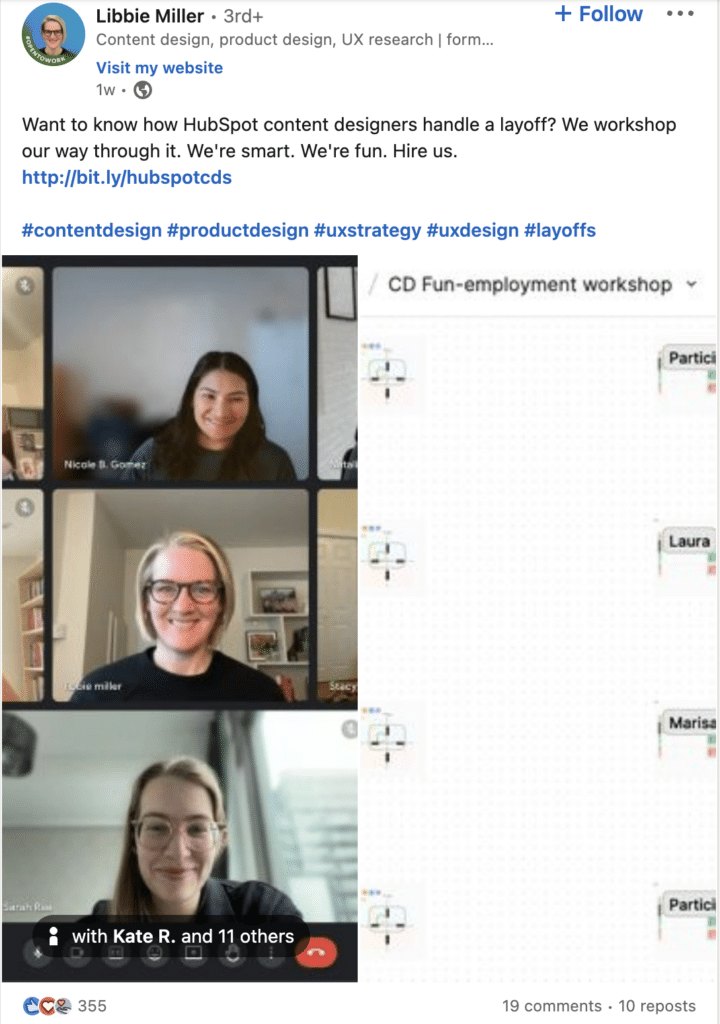
Build and diversify your portfolio.
If you’ve had an idea for a passion project, now is a great time to pursue it. Whether it’s starting a blog to help other people understand your field better, or prototyping a new product, your dream projects can fulfill you and help raise your profile. This is also a great time to revamp your portfolio and to upskill. A bootcamp or course can add to the skills you can show off to your future employers.
The Bottom Line
In the face of UX writing and content design layoffs, it’s normal to worry about the future. But rather than feeling hopeless, taking concrete steps can help you have a greater sense of agency in an uncertain time. Whether you are employed or looking for work after a layoff, you can combine an awareness of the challenges we face with the resilience to keep going.



